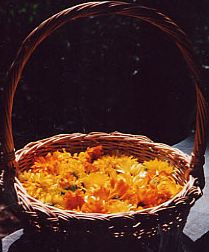Calendula
By: Jessica Godino, Red Moon Herbs
Although we haven't had a frost yet in the mountains of North Carolina, we have had several really cold nights. Many of the plants in the garden are turning yellow and dying back. But my Calendula patch looks happier than ever. In fact, the plants have put out a whole new set of blossoms since I picked them a few days ago. These hardy plants will live and continue to bloom well into the winter. And though I will miss them when they die, I know that next spring new plants will sprout from this year's seeds, ensuring another year's harvest.
Calendula, or Calendula officinalis, is prized for its beauty and adaptability. In fact, though it is native to Europe gardeners have spread it around the world. Its flowers, ranging in color from mild yellow to deep orange, have been called "golden drops of sunshine." This cheerful litle flower deserves a place of honor in every medicine cabinet and every garden.
Calendula has a wide range of uses, but where it shines brightest is as a vulnerary or wound healer. It is useful on all external skin problems and injuries but especially those that are red, tender, and oozing. It will also help to heal burns, bruises, and sprains. It decreases swelling, clears infection, speeds tissue regeneration, and prevents scarring. It can even heal old scar tissue! I also enjoy using Calendula when I don¹t have any injuries; it makes normal skin softer and healthier and is delightful for massage.
Taken internally, Calendula gently supports the immune system, especially during times of transition. As the season shifts from summer to fall, many of us are susceptible to colds and flus. Calendula's healing starts by example, as she not only survives but thrives through the change in seasons. Calendula raises immunity by stimulating lymphatic drainage. The lymph is an essential part of the immune system, filtering and eliminating waste products and bacteria as well as producing infection-fighting cells. Calendula is also anti-microbial and anti-viral. I use this herb to help heal swollen glands, low fevers, skin rashes, eczema, acne, cold sores, herpes, hepatitis, mastitis, yeast infections, varicose veins, hemorrhoids, ovarian cysts, jaundice, and much more.
Being so adaptable, Calendula will offer its healing in almost any form you choose to use. My favorite preparation for external use is an oil or salve of the fresh flowers. Internally you can use Calendula flower tincture, tea, or even the juice pressed from the fresh plant. The dosage for the tincture is 25-75 drops, 1-4 times per day. The English used to add the dried flowers to soups throughout the winter months. You can also add the fresh petals to salads. However you chose to use it, Calendula offers a gentle yet powerful medicine to help us move gracefully through many challenging situations.
Created by Jessica Godino, 2002
Jessica Godino has been teaching people about herbal medicine for almost two decades. After training with Susun Weed she co-founded Red Moon Herbs, an herbal medicine company. Her deep love for the plants and easygoing teaching style makes learning about herbal medicine accessible to everyone. She lives in Asheville, North Carolina where she practices acupuncture and teaches herbal medicine. She can be reached at http://www.fourflameshealing.com/.

Other Articles by Jessica Godino include:
Wildcrafting Guidelines - ten steps to follow
Spring Tonics - Stinging Nettle, Chickweed, and Dandelion
Usnea - a versatile immune system tonic
Violet - a nutritional and medicinal powerhouse
Hawthorn - a gentle but powerful tonic for the heart
Vitex - a supreme hormonal tonic for women
This article is brought to you by:

~ Susun Weed's Wise Woman Web ~
